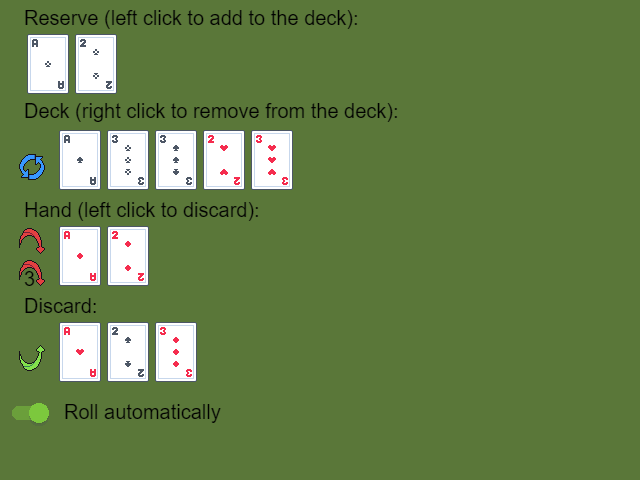How to work with randomness?
Pick a random number
Random numbers can be generated using the expressions: Random, RandomFloat, RandomFloatInRange, RandomInRange and RandomWithStep.
Create a random object
Random objects can be created according to a random number.
Roll dice
Rolling one die is the same as picking a random number between 1 an 6 using the expression RandomInRange(1, 6). But, rolling 2 dice is not the same as picking a number between 2 and 12. Indeed, there is only one way to make a 2 with:
- 1 and 1
whereas there are 6 ways to make a 7:
- 1 and 6
- 2 and 5
- 3 and 4
- 4 and 3
- 5 and 2
- 6 and 1
Rolling 2 dice is actually the same as picking 2 numbers between 1 and 6 and adding them together using this expression RandomInRange(1, 6) + RandomInRange(1, 6).
Tip
Using a roll of several dice to pick a random number can be a good tool for fairness as it's more likely to give a value closer to the middle.
Pick cards from a deck
The Array tools extension can be used to shuffle arrays.
The Object stack extension can be used to shuffle objects.
Tip
Even if a game is not about cards, using a deck can be a good tool for fairness as it gives more control over what happens in a time frame.
Card system example
Make randomness feel fair
Randomness is actually more than just picking random numbers. Finding a suitable level of randomness for a game is part of game design.
Chose better random sequences
A Tetris run where a player never gets an "I" piece doesn't sound fair nor fun. However, this could happen if a 7-sided die is rolled to choose the next piece. Indeed, there is a 6/7 chance not to roll an "I" each time.
To ensure that every type of piece is given to players regularly. The next 14 pieces can be decided in advance. For instance, it can be decided to give 2 pieces of each type. To still give some randomness, the order can be shuffled like a deck of cards.
Tip
Learn how to shuffle a deck.
Make something more or less rare
One way to make something rarer than another is to choose a probability for each thing to happen. For instance, 10% chance for a rare item, a 25% chance for an uncommon item and 65% for a common item.
Defining the probability of each quality level is fine when there are only a few of them, but some games like Pokemon can have hundreds of quality levels. In this case, it's faster to calculate the quality rather than listing every case.
Bell-shaped functions are often used to show how many people have a given characteristic, a person's IQ for instance. Most peoples are in the center where the curve is high and the curve goes down as it becomes rarer and rarer to find people. Most of these curves have complicated formulas, but rolling several dice gives similar results.
Tip
Learn how to roll dice.
